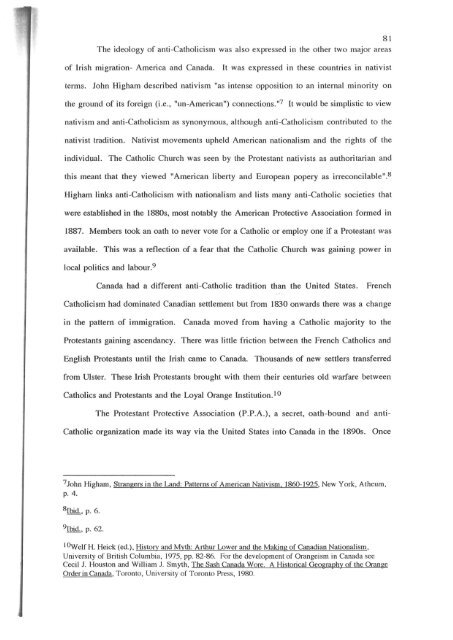TRANSPLANTED IRISH INSTITUTIONS - University of Canterbury
TRANSPLANTED IRISH INSTITUTIONS - University of Canterbury
TRANSPLANTED IRISH INSTITUTIONS - University of Canterbury
Create successful ePaper yourself
Turn your PDF publications into a flip-book with our unique Google optimized e-Paper software.
81<br />
The ideology <strong>of</strong> anti-Catholicism was also expressed in the other two major areas<br />
<strong>of</strong> Irish migration- America and Canada. It was expressed in these countries in nativist<br />
terms. John Higham described nativism "as intense opposition to an internal minority on<br />
the ground <strong>of</strong> its foreign (i.e., "un-American") connections. "7 It would be simplistic to view<br />
nativism and anti-Catholicism as synonymous, although anti-Catholicism contributed to the<br />
nativist tradition. Nativist movements upheld American nationalism and the rights <strong>of</strong> the<br />
individual. The Catholic Church was seen by the Protestant nativists as authoritarian and<br />
this meant that they viewed "American liberty and European popery as irreconcilable".8<br />
Higham links anti-Catholicism with nationalism and lists many anti-Catholic societies that<br />
were established in the 1880s, most notably the American Protective Association formed in<br />
1887. Members took an oath to never vote for a Catholic or employ one if a Protestant was<br />
available. This was a reflection <strong>of</strong> a fear that the Catholic Church was gaining power in<br />
local politics and labourY<br />
Canada had a different anti-Catholic tradition than the United States.<br />
French<br />
Catholicism had dominated Canadian settlement but from 1830 onwards there was a change<br />
in the pattern <strong>of</strong> immigration.<br />
Canada moved from having a Catholic majority to the<br />
Protestants gaining ascendancy. There was little friction between the French Catholics and<br />
English Protestants until the Irish came to Canada. Thousands <strong>of</strong> new settlers transferred<br />
from Ulster. These Irish Protestants brought with them their centuries old warfare between<br />
Catholics and Protestants and the Loyal Orange Institution. I 0<br />
The Protestant Protective Association (P.P.A.), a secret, oath-bound and anti-<br />
Catholic organization made its way via the United States into Canada in the 1890s. Once<br />
7John Higham, Strangers in the Land: Patterns <strong>of</strong> American Nativism. 1860-1925, New York, Atheum,<br />
p. 4.<br />
8Ibid., p. 6.<br />
9Ibid., p. 62.<br />
I Owelf H. Heick (cd.), History and Myth: Arthur Lower and the Making <strong>of</strong> Canadian Nationalism,<br />
<strong>University</strong> <strong>of</strong> British Columbia, 1975, pp. 82-86. For the development <strong>of</strong> Orangeism in Canada see<br />
Cecil 1. Houston and William J. Smyth, The Sash Canada Wore. A Historical Geography <strong>of</strong> the Orange<br />
Order in Canada, Toronto, <strong>University</strong> <strong>of</strong> Toronto Press, 1980.
















